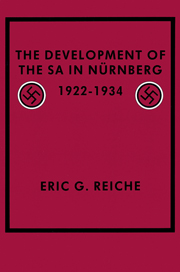Book contents
- Frontmatter
- Contents
- List of tables, figures, and maps
- Acknowledgments
- Introduction
- Abbreviations
- 1 Nürnberg and the emergence of National Socialism
- 2 Enter the stormtroopers: the Nürnberg SA, 1922–1923
- 3 “The guarantor of unity”: Nürnberg's SA between 1924 and 1929
- 4 Ready to assume power: the SA during the Great Depression
- 5 “The party bosses are our misfortune”: the Stegmann revolt, November 1932 to March 1933
- 6 The illusion of power: from the advent of the Third Reich to the Röhm putsch
- Conclusion
- Notes
- Bibliography
- Index
1 - Nürnberg and the emergence of National Socialism
Published online by Cambridge University Press: 21 October 2009
- Frontmatter
- Contents
- List of tables, figures, and maps
- Acknowledgments
- Introduction
- Abbreviations
- 1 Nürnberg and the emergence of National Socialism
- 2 Enter the stormtroopers: the Nürnberg SA, 1922–1923
- 3 “The guarantor of unity”: Nürnberg's SA between 1924 and 1929
- 4 Ready to assume power: the SA during the Great Depression
- 5 “The party bosses are our misfortune”: the Stegmann revolt, November 1932 to March 1933
- 6 The illusion of power: from the advent of the Third Reich to the Röhm putsch
- Conclusion
- Notes
- Bibliography
- Index
Summary
That the Nazi party did not make its formal debut in Nürnberg until October 1922 could be seen either as historical irony or as yet another confirmation of the frequently ambiguous relationship between Nürnberg and Munich, capital of Bavaria. In Munich, Adolf Hitler had for the past three years busily and effectively transformed the NSDAP from a nearly unknown organization into a party increasingly familiar and disruptive – not the least because of the strong-arm tactics of the stormtroopers who worked in often uneasy alliance with the NSDAP. For nearly as long, the notorious anti-Semite Julius Streicher, local head of a völkisch rival organization, had resisted Hitler's attempts to gain a foothold in Nürnberg. The city whose name would some day become synonymous with the bombast and legalized brutality of Nazism thus initially represented to Hitler a source of opposition in his quest to gain domination over the völkisch movement.
Yet Nürnberg and Munich had frequently represented different aspects of German and Bavarian development. Situated about 120 kilometers north of Augsburg and 200 kilometers southeast of Frankfurt on the Main, medieval Nürnberg capitalized on its political importance as a residence of the Hohenstauffens to build up a far-flung network of trade that placed it athwart seven major trading routes linking the city with Antwerp in the northwest, Hamburg in the north, Prague and Breslau to the east, Venice in the south, and Geneva and Lyon to the southwest. The prosperity of its patriciate, which dominated the free imperial city politically until the beginning of the nineteenth century, combined with the productivity of a flourishing artisanate and the artistic genius of such people as Hans Vischer, Veit Stoss, and Albrecht Dürer, made Nürnberg a center of both trade and artistic life.
- Type
- Chapter
- Information
- The Development of the SA in Nurnberg, 1922–1934 , pp. 1 - 19Publisher: Cambridge University PressPrint publication year: 1986



